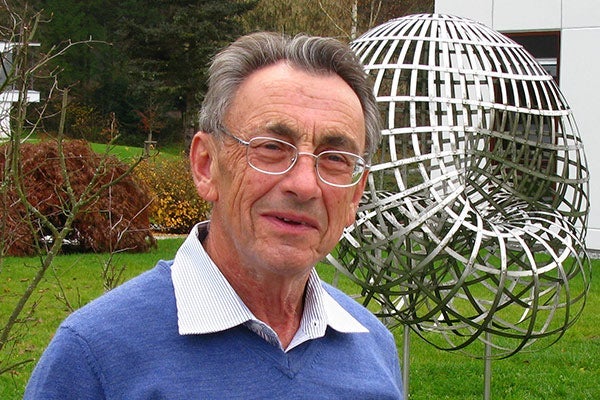Grigori “Grisha” Mints, a professor of philosophy and, by courtesy, of mathematics and of computer science at Stanford, died May 29 after being hospitalized with pneumonia. He was 74 years old.

A world-renowned logician, Grigori Mints is remembered for his genuine engagement in his work as a teacher and a scholar. (Image credit: Courtesy Archives of the Mathematisches Forschungsinstitut Oberwolfach)
Considered one of the most distinguished logicians in the world, Mints was passionate about the applications of logic to philosophy. His expertise was in proof theory – the analysis of the structure of mathematical reasoning.
Mints’ significant contributions to the world of logic have been recognized by his election to the Estonian Academy of Sciences in 2008 and the American Academy of Arts and Sciences in 2010.
Philosophy Department Chair Lanier Anderson described Mints as an academic who “combined great intellectual intensity and seemingly boundless energy with a captivating sense of fun and a gift for illuminating historical analogies and connections. All of us will miss his ready, twinkling smile in the department lounge and his energetic presence in department life.”
Genuinely engaged in his work as both teacher and scholar, Mints taught advanced courses and directed graduate student work, and also enjoyed giving freshman seminars, where he introduced students to proof theory and its applications.
Mints, who joined the Stanford faculty in 1991, was teaching, researching and traveling until the time of his death.
“Mints was a mainstay and fixture of Stanford Philosophy’s logic group for nearly 25 years, leaving an indelible mark on generations of students and colleagues,” said Solomon Feferman, professor emeritus of mathematics and of philosophy, at a recent Center for the Study of Language and Information workshop.
“We worked closely side by side in the logic seminar and on all matters having to do with the status of logic here,” Feferman said, adding that Mints’ active research helped maintain Stanford as a leading center in the world for proof theory.
Mints was a proponent and developer of the “epsilon substitution method,” a rigorous theory of proofs first developed by the German mathematician David Hilbert. According to Anderson, Mints was almost single-handedly leading the way to develop Hilbert’s method and expand its range of applications to such fields as computer science.
Mints’ broad-ranging work also included important contributions to the development of non-classical logics, intuitionistic logic, modal logic, automated deduction and constructive mathematics.
Bringing the world of logic to new minds
Mints’ publications include two introductory books on modal and intuitionistic logic. He also wrote hundreds of scholarly papers and thousands of reviews.
He maintained his international intellectual connections throughout his career despite some difficult years working in Russia during the Cold War. Some of the early papers from his days in the former Soviet Union were collected in the book Selected Papers in Proof Theory; its main topic is putting proofs into a normal form that makes it possible to reason mathematically about the proofs themselves as mathematical objects.
Feferman noted that Mints worked tirelessly to bridge the different academic worlds in which he worked, particularly between the research traditions of his colleagues in the former Soviet Union and those of his Western collaborators.
Stanford Philosophy Professor Johan van Benthem remembered Mints as a person who was widely admired for his direct and personal approach. His “love of clear and brief phrasing summarized a familiar situation in often unusual and totally novel ways.”
Born on June 7, 1939, in St. Petersburg, Russia, Mints obtained degrees in mathematics from the Leningrad State University (BA and MS in 1961, PhD in 1965 and ScD in 1990).
He held research positions at the Steklov Mathematical Institute, the Leningrad University and the Estonian Academy of Sciences before coming to Stanford.
Like many at Stanford, Feferman feels Mints’ loss deeply as both colleague and friend.
“His passing will leave a hole that will be very hard to fill,” Feferman said.
“All of us will fondly remember his constant striving to bring colleagues and collaborators as well as new students into contact with the Stanford logic group, thereby opening up the world of logic to new minds,” Anderson said.
Philosophy Assistant Professor Thomas Icard – a former graduate student of Mints’ who worked closely with him from 2008 to 2013 – admired Mints’ great intellect, deep understanding of logic and mathematics, and his approachability as a teacher.
“I always felt I could drop into Grisha’s office at any time, whether to discuss some topic or problem in logic or, quite often, 19th- and 20th-century Russian literature and history. He always had a smile on his face, made anyone feel at ease – even when discussing technical issues in logic – and always had a distinctively Russian joke for every occasion. He will be greatly missed,” Icard said.
Fellow logician Richard Zach, a professor of philosophy at the University of Calgary, posted a memorial on his blog expressing his gratitude for being able to meet Mints and study with him.
“He was a demanding teacher,” wrote Zach, “but I learned a lot. Whenever I [visited], he would ask me what I was working on, and he’d acknowledge what I’d said with a smile and a sideways nod and ‘um-hmm.’ Often he would then tell me about some obscure, usually Soviet-era, book or paper that addressed all the problems and questions I had. Then came the part where he’d tell me about his current work, and I would struggle to keep up. I’ll always fondly remember those visits. He was a wonderful, generous teacher and colleague.”
Mints is survived by his wife, Marianna Rozenfeld; daughter, Anna Reznikova; grandson, Alexandre Reznikov; and great-granddaughter, Viktoria Reznikova.
A public memorial event for Stanford colleagues is planned for the fall.
Tanu Wakefield is the communications assistant at the Stanford Humanities Center.